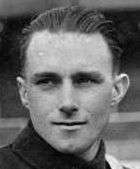Ron Johnson (speedway rider)
 | |
| Born |
24 February 1907 Duntocher, Scotland |
|---|---|
| Died | 1983 (aged 75) |
| Nationality |
|
| Current club information | |
| Career status | Deceased |
| Career history | |
| 1929-1933 | Crystal Palace Glaziers |
| 1934-1951 | New Cross |
| ? | Ashfield Giants |
| ? | West Ham Hammers |
| ? | Edinburgh Monarchs |
| Individual honours | |
| 1945, 1946 | London Riders' Championship |
| 1945 | Scottish Champion |
| 1956 | WA State Champion (Aust) |
| Team honours | |
| 1938, 1948 | National League Champion |
| 1931, 1934, 1937, 1947 | London Cup |
Ron Johnson (24 February 1907 Duntocher, Scotland[1] – 4 February 1983) was a speedway rider who won the London Riders' Championship in 1945 (unattached) and in 1946 whilst with the New Cross Rangers.[2][3]
Johnson (Born Johnston) emigrated to Australia with his parents when he was just a child. He started racing at the Claremont Speedway in Perth, Western Australia in 1927 (the same year the venue first held racing), before his travelling to the UK with promoter Johnnie Hoskins in 1928 to start a career with Crystal Palace. Johnson initially struggled on British tracks that were half the size of the ones he was used to (the Claremont Showgrounds, which doubled as the speedway, was some 550 metres (600 yd) in length, while other Australian tracks of the day, usually showground tracks, ranged from 450 metres (490 yd) to 610 metres (670 yd) in length).[4][5] In 1934 he joined the New Cross Rangers, with whom he retained connections throughout his career. It was only in the 1939 season that he began to show the form that would see him regarded as one of the top riders of his era.[5]
Injuries
Johnson's career was beset with injuries. In 1935 he was involved in a crash which saw team mate Tom Farndon suffer fatal head injuries at New Cross. Johnson had multiple lacerations to his arm which kept him from competing in the Star Riders' Championship final.
Up until 1949 he had lost a toe (after a crash at Exeter in 1929) and the tops of two of his fingers (after catching them in his chain in 1931) as results of track injuries.[4] However on 1 August 1949, he had a huge crash at Wimbledon. He was following his team mate Cyril Roger for a 5-1 heat win. Roger wobbled in front of him and Johnson fell. As he got back onto his feet he was hit by Wimbledon rider Cyril Brine and knocked down, suffering a fractured skull. He also suffered a near fatal blood clot. This clot may have been jolted loose, thus saving his life, by one stretcher bearer who was walking out of step with the others when Johnson was removed from the track. Doctors wanted Johnson to stay in hospital for six months but he discharged himself after a month.
Comebacks
Johnson attempted a comeback in 1950 but was nothing like the rider he was before the near-fatal accident. His form did not improve in 1951 so dropped down a division to ride for the Glasgow Giants. His form failed to improve there so retired and returned to Australia.
After a couple of years Johnson made a comeback the Claremont speedway in Perth, winning the West Australian Solo Championship title in the 1954-55 season. He wanted to return to New Cross but they had closed down, so he returned to the UK for an ill fated spell with the West Ham Hammers but again failed to perform to anywhere near his pre-1949 levels. He returned home to Australia after friends in the UK helped him with his fare.
New Cross re-opened in 1959 and Johnson decided to make another comeback attempt, at the age of fifty-two. However, he was unable to keep up even with the juniors. He captained the New Cross Colts in a match against Edinburgh and scored three points with a race win which showed flashes of his old brilliance. He then tried his luck with the Edinburgh Monarchs but scored just one point (plus one bonus point)in six matches and eventually returned to Australia. There was further talk of him coming back in 1963 when New Cross entered the Provincial League and although he came back to Britain and settled near the track, the proposed comeback came to nothing,although he did take to the track once more on 14 May that year, defeating Phil Bishop 2-1 in a second half match race series.[6]
After retirement
It has been said that in 1968 Johnson was involved in a road accident and suffered serious injuries to leave him using a wheelchair for the rest of his life. This however is not true as he had recovered sufficiently and lived modestly in Thornlie, Western Australia, where his granddaughter visited from time to time and shared his love of motor bikes. He was still active and tinkering with his much loved Bentley and his old BSA in 1981.
Ron Johnson died in 1983 at the age of 75.
World Final Appearances
- 1939 -
 London, Wembley Stadium - Event cancelled due to World War II
London, Wembley Stadium - Event cancelled due to World War II
References
- ↑ Bamford, R. & Stallworthy, D. (2003) Speedway - The Pre War Years, Stroud: Tempus Publishing. ISBN 0-7524-2749-0
- ↑ Belton, Brian (2003). Hammerin' Round. ISBN 0-7524-2438-6
- ↑ Jacobs, Norman (2001). Speedway in London. ISBN 978-0-7524-2221-3
- 1 2 Morgan, Tom (1947) The People Speedway Guide, Odhams Press, p. 76
- 1 2 Storey, Basil (1947) "Heart-Breaks Then Fame" in Speedway Favourites, Sport-in-Print, p. 20
- ↑ Jacobs, Norman (2008). Out of the Frying Pan. ISBN 978-0-7524-4476-5